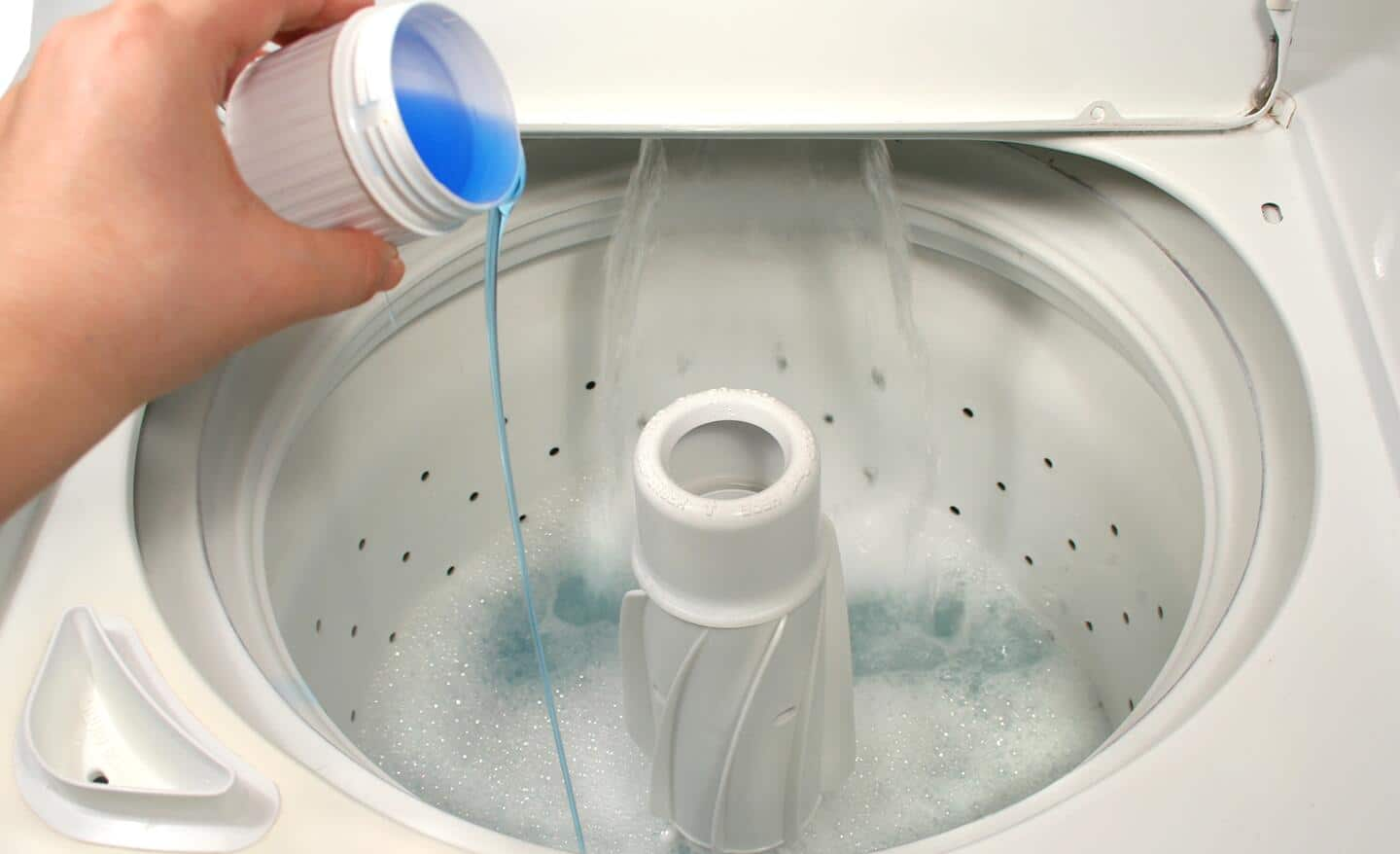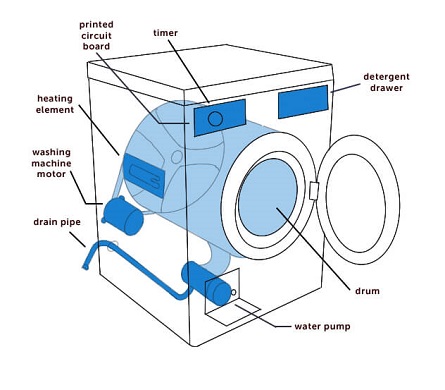Have you ever opened your washing machine, expecting an empty drum, only to find it holding a pool of water? It’s a confusing sight, isn’t it?
You might wonder why there’s water lurking in there when your machine isn’t even in use. This unexpected wet surprise can be more than just a minor annoyance; it could be a sign of an underlying issue that needs your attention.
Before you shrug it off or panic, let’s explore why this happens and what you can do about it. Understanding the reasons behind this mystery will not only put your mind at ease but also help you keep your appliance in top shape. Ready to dive into the details? Let’s unravel this watery puzzle together.

Credit: www.homedepot.com
Common Causes Of Water Retention
Water can accumulate in a washing machine drum due to blocked drainage pipes. Faulty water valves might also cause this issue. Regular maintenance helps prevent unexpected water buildup.
Finding unexpected water in your washing machine drum can be quite puzzling. You might wonder why it’s happening and how you can stop it. Understanding the common causes of water retention is crucial to solving the problem and ensuring your laundry routine goes smoothly.
Faulty Water Inlet Valve
A faulty water inlet valve is a common culprit. This valve controls the flow of water into your machine. If it’s not shutting off properly, water may continue to seep into the drum even when the machine is off. Think of it like a leaky faucet—annoying and wasteful. You might notice a slow trickle of water accumulating over time. If you suspect this is the issue, replacing the valve is often the best solution.
Clogged Drain Hose
A clogged drain hose can also lead to unwanted water retention. The drain hose is responsible for removing water from the drum after each cycle. If it’s blocked, water can back up and settle in the drum. Check for any visible kinks or obstructions in the hose. Sometimes, a simple cleaning can solve the problem. This issue can often be fixed quickly if you catch it early.
Malfunctioning Water Pump
The water pump plays a vital role in expelling water from the machine. If it’s malfunctioning, water can remain in the drum. A faulty pump can make strange noises or fail to drain water effectively. Regular maintenance and checking the pump for signs of wear can prevent this. If you notice any unusual behavior, it might be time to repair or replace the pump.
Blocked Filters
Blocked filters can disrupt the normal flow of water. Filters trap debris and lint, preventing them from clogging the system. However, when they’re blocked, water can’t drain properly, leading to retention in the drum. Cleaning the filters regularly is a simple yet effective way to avoid this issue. When was the last time you checked them? A little attention can save you from bigger headaches down the road. By addressing these common causes, you can enjoy a hassle-free laundry experience. Regular checks and maintenance can prevent these issues from turning into costly repairs. Is it time to give your washing machine a little TLC?
Diagnosing The Problem
Water lingering in your washing machine drum when it’s not in use can be a puzzling issue. You might worry about potential damage or increased water bills. Diagnosing the problem is crucial to finding a solution. Here’s how you can identify what’s causing the water build-up, ensuring your washing machine runs smoothly without any unwanted surprises.
Inspecting The Inlet Valve
Start by examining the inlet valve. This valve controls the flow of water into the machine. If it’s faulty or blocked, it might let water seep into the drum even when the machine is off.
Check for visible signs of wear or damage. You can also test the valve by turning off the water supply and seeing if the drum continues to fill. A faulty valve might need replacing to prevent unwanted water entry.
Checking The Drain Hose
The drain hose can be another culprit. If it’s clogged or improperly positioned, water might backflow into the drum. Make sure the hose is securely attached and free from obstructions.
Sometimes, adjusting the hose’s height can prevent water from flowing back into the drum. A simple inspection can save you from potential water overflow issues.
Examining The Water Pump
The water pump plays a vital role in expelling water from the machine. If it’s malfunctioning, water might remain in the drum. Listen for unusual noises when the machine is running; these can indicate a problem with the pump.
Consider consulting a professional if you suspect the pump is failing. Replacing a malfunctioning pump can ensure efficient water drainage.
Cleaning The Filters
Filters can easily become clogged with debris, hindering water flow. Regular cleaning can prevent blockages that might cause water to remain in the drum.
Take out the filters and rinse them under running water. This simple task can improve water drainage significantly. How often do you clean your washing machine filters?
By diagnosing these common issues, you can tackle the mystery of water in your washing machine drum. Regular maintenance checks can save you time and money, helping your machine perform its best. What steps will you take to ensure your washing machine stays in top shape?
Quick Fixes And Solutions
Discovering water in your washing machine drum can be frustrating. It suggests issues that need quick solutions. Addressing these problems promptly saves time and prevents damage. Simple fixes can restore your machine’s efficiency. Dive into these solutions to tackle the issue head-on.
Repairing Or Replacing The Inlet Valve
The inlet valve controls water flow into your washing machine. Faulty valves lead to unwanted water accumulation. Check the valve for any signs of wear or damage. If it’s broken, replacing it might be necessary. A new valve ensures proper water regulation.
Unclogging The Drain Hose
A clogged drain hose can cause water to stay in the drum. Inspect the hose for any blockages. Remove any debris or buildup inside. A clear hose ensures smooth water drainage. Regular inspection prevents future clogs.
Fixing The Water Pump
The water pump expels water from the drum after each cycle. If malfunctioning, water remains in the drum. Listen for unusual sounds during operation. These indicate pump issues. Repairing or replacing the pump solves the problem.
Regular Filter Maintenance
Filters keep your washing machine running smoothly. Dirty filters affect water drainage and efficiency. Clean them regularly to prevent buildup. A clean filter ensures better performance. Routine maintenance avoids long-term issues.
Preventative Measures
Ever wondered why there’s water sitting in your washing machine drum when it’s supposed to be dry? It’s not just a minor inconvenience; it could lead to mold growth, unpleasant odors, or even damage your machine over time. Addressing this issue means taking preventative measures to avoid these problems before they start. Let’s dive into how you can keep your washing machine in tip-top shape.
Routine Maintenance Tips
Consistency is key. Regularly inspect the hoses connected to your washing machine. Look for cracks or leaks, and replace them if needed.
Don’t forget to clean the lint filter. A clogged filter can cause water to back up and remain in the drum.
Check the seals and gaskets around the door. If they’re worn or damaged, they might not be keeping water out effectively.
Best Practices For Washing Machine Care
Keep your washing machine balanced. An uneven machine can cause water to pool in the drum.
Be mindful of the detergent you use. Excessive suds can trick your washer into leaving behind water.
After a wash cycle, leave the door slightly open. This helps air out the drum and prevents water from collecting.
Have you ever thought about the implications of neglecting these simple steps? Imagine a machine full of stagnant water—and the smell! Taking action can save you hassle and money in the long run.
Think back to the last time you had to deal with a major appliance repair. Not fun, right? Regular maintenance could make those headaches a thing of the past.
Remember, your washing machine is an investment. Treat it like one by following these preventative measures. Your future self will thank you!
When To Call A Professional
Water in the washing machine drum when not in use could signal a plumbing issue. It might be wise to contact a professional if you notice this problem, as it could prevent further damage. A quick inspection can save time and money.
When your washing machine drum mysteriously fills with water when not in use, it’s a signal that you might need professional help. While some issues are easy to fix on your own, others require the expertise of a trained technician. But how do you know when to make that call? Let’s dive into some practical insights and scenarios.
Identifying Complex Issues
Sometimes, the problem might go beyond your DIY skills. If you’ve checked for clogs and leaks and everything seems fine, yet water still pools in your drum, it could be a complex issue like a malfunctioning water inlet valve. Another sign is if the water appears dirty or has a foul smell. This could indicate a backflow issue, which might require specific tools and knowledge to fix. Ask yourself: Is this something I can confidently tackle, or am I in over my head? If it’s the latter, professional help is your best bet.
Cost-benefit Analysis Of Professional Help
Hiring a professional might seem costly at first, but consider the potential savings. A small problem, if misdiagnosed, can lead to bigger damage and higher repair costs down the line. Think about your time as well. While you could spend hours troubleshooting, a professional can often fix the issue quickly and efficiently. Plus, most professionals offer a guarantee on their work, giving you peace of mind. Is it worth risking a bigger problem just to save a few bucks now? When I faced this issue, I initially hesitated to call a technician, thinking I could handle it myself. But after a few failed attempts, I realized that a professional could save me time and prevent further damage. It was the right decision, and I learned that sometimes, expert help is the most practical solution. Isn’t your peace of mind worth the call?

Credit: www.reddit.com

Credit: www.domesticandgeneral.com
Frequently Asked Questions
Why Is There Water In My Washing Machine Drum?
Water can remain due to a clogged drain or faulty water inlet valve. Check these parts for issues.
How Do I Fix Water In My Washing Machine Drum?
Inspect the drain hose for blockages. Ensure the water inlet valve is functioning properly. Consult a professional if needed.
Can Standing Water Damage My Washing Machine?
Yes, standing water can cause mold and mildew. It may also damage the drum over time. Address it promptly.
Is It Normal For Water To Stay In The Drum?
No, it’s not normal. It indicates a possible issue with drainage or water supply. Investigate the cause.
Should I Call A Technician For Water In The Drum?
If basic checks don’t resolve the issue, calling a technician is advisable. They can identify and fix the problem.
Conclusion
Understanding why water stays in your washing machine drum matters. It helps prevent mold and unpleasant odors. Regular maintenance can solve minor issues. Check hoses and valves often. Clean the machine to ensure smooth operation. If problems persist, contacting a professional is wise.
Regular care keeps your washing machine efficient. Avoiding stagnant water protects your appliance and keeps clothes fresh. Awareness and simple checks can save time and money. Remember, a well-maintained washer brings peace of mind. Keep your laundry routine hassle-free and your machine in top shape.
Stay proactive to enjoy clean, fresh laundry every time.




